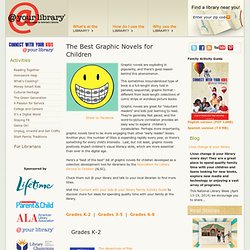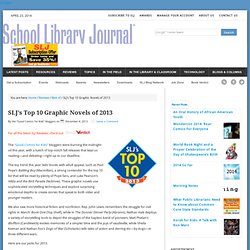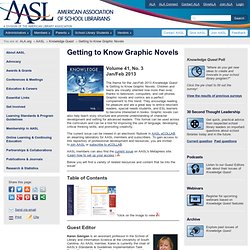

Maverick Graphic Novel Reading List. The Best Graphic Novels for Children. N/a.

S Top 10 Graphic Novels of 2013. The “Good Comics for Kids” bloggers were burning the midnight oil this year, with a batch of top-notch fall releases that kept us reading—and debating—right up to our deadline.

The top trend this year: kids’ books with adult appeal, such as Paul Pope’s Battling Boy (Macmillan), a strong contender for the top 10 list that will be read by plenty of Pope fans, and Luke Pearson’s Hilda and the Bird Parade (Nobrow). These graphic novels use sophisticated storytelling techniques and explore surprising emotional depths to create stories that speak to both older and younger readers. We also saw more historical fiction and nonfiction. Rep. John Lewis remembers the struggle for civil rights in March: Book One (Top Shelf), while in The Donner Dinner Party (Abrams), Nathan Hale deploys a variety of storytelling tools to depict the struggles of the hapless band of pioneers. Here are our picks for 2013. Great Graphic Novels. Skip to main content Great Graphic Novels Great Graphic Novels for Teens is a list of recommended graphic novels and illustrated nonfiction for those ages 12-18, prepared yearly by YALSA.

Visit YALSA's Teen Book Finder Database, a one-stop shop for finding selected lists and award winners. Users can search this free resource by award, list name, year, author, genre and more, as well as print customizable lists. Graphic Novels for Non-GN Readers. Have you finished all your Christmas shopping, or do you still have 10 gifts to find?

If, like me, you like to give books as gifts, it can be a challenge to strike the right balance between a book you know someone will enjoy and a book that will give them a new experience. Microsoft Word - UB ALA what why and how.doc - UBALAwhatwhyandhow.pdf. Graphic Novels. The guests for this episode are Carol Tilley, this year’s Trends in YA presenter, and Denise Agosto, organizer for the event.

The Trends in YA Presentation is an event that occurs each year at the Midwinter Conference. This year’s presentation will be on Saturday, January 26th at 4:30 in room 213 in the Seattle Convention Center. Tilley will read from her research paper, which explores the history of comic books and their relationship with libraries. For more information on Carol Tilley and her various projects, please visit her website at www.caroltilley.net/. You’ll find the schedule of other YALSA-related events on the YALSA webpage. Graphic Novels Trends. GET GRAPHIC: The World In Words and Pictures. WillEisner.com. Good Comics for Kids — A School Library Journal Blog. Atomic Raygun Comics, internet home of C. Michael Hall. Getting to Know Graphic Novels. Volume 41, No. 3 Jan/Feb 2013 The theme for the Jan/Feb 2013 Knowledge Quest is Getting to Know Graphic Novels.

Children and teens are visually oriented now more than ever, thanks to television, computers, and cell phones. Graphic Novels 101: FAQ. From the March/April 2006 issue of The Horn Book Magazine.

Understanding Comics: The Invisible Art: Scott McCloud: 9780060976255: Amazon.com. Faster Than a Speeding Bullet: The Rise of the Graphic Novel eBook: Stephen Weiner, Will Eisner. Comic Book Century: The History of American Comic Books (People's History): Stephen Krensky: 9780822566540: Amazon.com. The Librarian's Guide to Anime and Manga. Note: All Japanese names are in Japanese order, family name first.

Introduction: You may have had some very young, so cute from trying to look hip, library patron ask you, "Do you have any Gundam? " Or a serious student requesting the set of the Hakkenden, for a project on 19th century Japanese literature. Or had a club ask to use your meeting room to show anime. Or youngsters ask if you had books on how to draw manga. Back to contents Anime and Manga Terminology Titles Available both as Anime and Manga in the United States. Re-Dubbed vs Subtitled Anime One old controversy in anime fandom is over the preference between viewing anime that has been subtitled or re-dubbed into English.
Graphic Novels: Suggestions for Librarians. Introduction Graphic novels are one of the fastest growing categories in publishing and bookselling.

Today’s graphic novels are far more sophisticated and varied in content than the comics that preceded them and enjoy a level of respect previously denied to this form of popular entertainment: they are the subject of reviews, book-length surveys, museum exhibits and academic study, as well as recipients of prestigious literary awards (Art Speigelman’s Maus, for instance, won the Pulitzer Prize in 1992). As the U.S. News and World report phrased it, “The comic books of our youth [have] grown up.” While comics are published as magazines, their “grown up” version – the graphic novel – appears in book format. Narratives composed out of visual images or out of images and words have a very long history – a history that stretches back to the first cave paintings. How Graphic Novels Became the Hottest Section in the Library.
Photo: No Flying No Tights Robin Brenner, teen librarian at the Brookline Public Library in Massachusetts.

According to old stereotypes, it shouldn’t work—serious librarians should want nothing to do with the raucous, pulp world of comics—and for a long time it didn’t. But over the past decade, the graphic novel genre has become one of the fastest-growing at libraries of all kinds, as a new generation of librarians adopts the category as a means to energize collections and boost circulation and patronage. The audience of children and teens is growing, critical and academic recognition has confirmed comics’ literary and artistic value, and a new shelf of modern classics has arrived. The Librarian's Guide to Graphic Novels for Adults: David S. Serchay: 9781555706623: Amazon.com. It’s No Joke: Comics and Collection Development. By Christine Pyles on February 25, 2013 Adult comic book and graphic novel readers comprise one of the most underrepresented groups of readers by libraries today.The inclusion of comic books and graphic novels in libraries is a fairly new concept despite the fact that the first comic book was published in 1934.
Art Spiegelman’s Maus: A Survivor’s Tale brought the graphic novel to the attention of libraries in 1986. Maus signifies the point in the history of comics when it became acceptable to include them in a library collection (by some libraries) and questions surrounding their inclusion and classification still exist today. Prior to Maus, librarians never admitted to reading comics since “comics did not belong in libraries because they were not real books and nobody with intellectual sense (that is, the library’s perceived user) reads them anyway.”1 Today, many librarians do not hesitate to say “yes, comics should be in libraries.”
Graphic Novels: Suggestions for Librarians. NCAC provides this guide as a resource for librarians. We will make updated copies available as changes are made. If you have suggestions, or would like to request a printed copy, please email us © 2006 Prepared by The National Coalition Against Censorship, The American Library Association, & the Comic Book Legal Defense Fund. The Librarian's Guide to Graphic Novels for Children and Tweens: David S. Serchay: 9781555706265: Amazon.com. Offices of the American Library Association. This is part of a larger project, Graphic Novels: Suggestions for Librarians (PDF), created by the National Coalition Against Censorship, the Comic Book Legal Defense Fund, and the American Library Association. For additional help in dealing with challenges, see Support for Dealing with or Reporting Challenges to Library Materials.
In theory, dealing with challenges to graphic novels is no different than dealing with challenges to print material. In practice, however, it is important to keep in mind that many people consider an image to be far more powerful in its impact than any written description of that image. That said, the following tips will help you prepare to cope with challenges to graphic novels. 1. Using Graphic Novels in Education. Best Sellers. A graphic novel review website. GraphicNovelReporter. Graphic Novel Reviews.